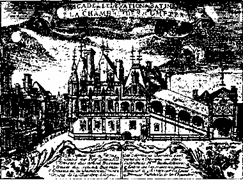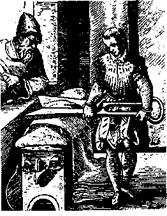home
 Economy Economy
 books books
 The history of the world economy - Polyak GB The history of the world economy - Polyak GB
|
The history of the world economy - Polyak GB
10.4. The economic development of France at the stage of the decay of feudalism
The situation of the peasants. Consequences of Great Geographical Discoveries
At the late Middle Ages, when there was the expansion of the feudal mode of production, France was superior to all the other Western European countries (states) in terms of population: here lived 15 million people..
The main branch of the economy was agriculture, and the most numerous class - the peasantry. Since there is still a monopoly of noblemen in the land, the peasants were the main categories of land holders - tsenzitariyami. As noted, it has spread sharecropping and sharecropping agreement. French farmers are paid and natural rents (Shamparov), burdensome to the peasant economy. Even more serious was the payment of dues money - chinsha. In favor of the king bears a royal chanced, and in favor of the church - tithing.
At the same time there were changes, capitalist relations were born in the French economy. On the economic development of France in the XVI century. influenced "price revolution". As a result of rising food prices, increased by 2.5 times, the ruin of small and medium nobility gained widespread. The situation has not improved the peasants, because they were the major taxpayers, and taxes are constantly increasing. In XVI- XVII centuries. For this reason, many country revolts passed (for example, 1548, 1624, 1639 and the other, respectively.)
The consequence of Discovery was the growing role of port cities like Le Havre, Bordeaux, Dieppe, Nantes, and others. In a major center of trade fairs now turned Lyon.
France began the colonial conquests, expanded overseas trade, she captured Pondicherry in India, colonized Canada, the West Indies, the land on the Mississippi River. In 1664 he founded the East India Company.
Features of primitive accumulation of capital
In France, at this stage of the process of primitive accumulation of capital even though it had its own peculiarities. Unlike England, there was no mass landlessness of peasants and embourgeoisement nobility in France. The main channels of primitive accumulation of capital here began the tax system, government borrowing (public debt system), the sale of judicial and financial posts.

Accounts Chamber, XVII century.
Still remained particularly burdensome tax on salt - Gabel. Royal chanced, introduced in 1439, were charged with the land, property or poll. Since its size is not fixed, the tax collectors abused it, and suffered from the tyranny of their taxpayers. In 1549, along with a large (king) taley small Talya was introduced in France, intended to pay for the troops. In the XVI century. The lease system was introduced in France, and at the beginning of the XVII century. syurintendantom Finance M. Sully set obschefrantsuzsky mercy of tax - one of the most important sources of primitive accumulation of capital.
The system of public debt in France dates back to 1522, when King Francis I took the Parisian bankers borrowed 250 thousand livres at the rate of 10% per annum. From this period is extended speculation on the course of rent securities, interest rates are rising. The result was a tontine - inherit the right to receive interest on the government loans, which led to the formation of a layer of rentiers - those living on the interest from securities and usurious exploitation reinforced.
Through the process of primitive accumulation of capital there is the process of property stratification and landlessness of peasants. Wealthy bourgeois layers and took the opportunity to buy the rights of the nobility to collect rents, took at the mercy of the collection of indirect taxes, were engaged in a mortgage loan to buy land. All this testifies to the fact that it is not dominated by business in France, and loan-sharking operations and Taxed.
Many French bourgeoisie preferred to be officials of the huge administrative and judicial system and buying office for the money. As is known, absolutism in France reached its apogee under Louis XIV, in which flourished the royal court extravagance, favoritism, a huge bureaucracy, the most numerous of all states, large military expenditures. And all this is paid for tax-paying classes - peasants and artisans.
The development of manufactories. Kolbertizm
These features of the socio-economic. Development of France determined the originality and manufacturing. The first factory, which appeared in the XVI century., Were established in suknodelii, linen and silk production. A feature of the industrial development of France was predominant production of goods for the ruling class - luxury goods, perfumes, cosmetics. But unlike England, where the factory was built employing capitalist development in France manufactures state-supported.
French absolutism gave them monopoly rights, privileges, subsidies, pursued a policy of mercantilism, which is most developed at J. Colbert. Occupying the post of Comptroller General (Minister) of Finance, Colbert might state determines the amount of money held by him. The source of their replenishment Colbert seen in the trade. He is the founder of the East India and West India Companies. Colbert introduced a protectionist tariff, encouraged the development of the royal manufactory industry. State intervention in the economy has reached at Colbert greatest strength, and its economic policy came to be known as kolbertizma. protectionist measures system for trade surplus pursued Colbert, included: the prohibitive import duties on industrial goods, reduction of imports to a minimum; encouraging the development of domestic industry (export and importzameschayuschey); the establishment by the State of export of manufactures; the involvement of foreign masters; providing entrepreneurs industrialists privileges.

Workshop yuvilira
When Colbert in France have been developed only in the silk and woolen manufactures, and steel. There were credit institutions. Colbert has taken measures to unify tariffs and enlargement of internal customs areas, which contributed to the development of domestic trade, although manufactures products due to the low purchasing power of the masses was intended primarily for the export market. When Colbert was developed commercial and military French navy.

sheep shearer
Absolute monarchy
Background absolutism rooted in the socio-economic changes caused by the birth and development of bourgeois relations. As capital accumulation entrepreneurial elite formed in the new class. There are large fortunes. Get the development banks and national fairs.
The bourgeoisie, to replenish the state treasury, allowed the monarch contain an army of mercenaries and mercenary officials, to rise to the position of the autocrat, has absolute power in respect of all of his subjects, including the feudal lords, who will long remain a privileged class, to hold senior government positions, but that is absolute power limited sovereign rights.
Its the most complete implementation of the principles of absolute monarchy is in France. Kings achieve full control over all the provinces have the sole right to issue laws binding on all States, including on taxes and military service laws. There comes an end to the autonomy of the cities, no longer convened the States-General, at the mercy of the king falls church.
Having played for a certain time a positive role in the world historical process, an absolute monarchy in France becomes a hindrance to further development of the state.
Review Questions
1. Explain how the formation of feudal tenure in France.
2. Describe the category of farmers and their form depending on the lords, when there was switching rents its consequences.
3. Tell us about the communal revolution, the role of cities and their relationship with the feudal regime.
4. Explain how the formation of the absolute monarchy in France.
5. What consequences had great geographical discoveries on the economic development of France?
6. Expand the features of the process of primitive accumulation of capital in France.
7. What are the characteristics of the manufacturing production in France? What kolbertizm?


Comments
Commenting, keep in mind that the content and the tone of your messages can hurt the feelings of real people, show respect and tolerance to his interlocutors, even if you do not share their opinion, your behavior in terms of freedom of speech and anonymity offered by the Internet, is changing not only virtual, but real world. All comments are hidden from the index, spam control.